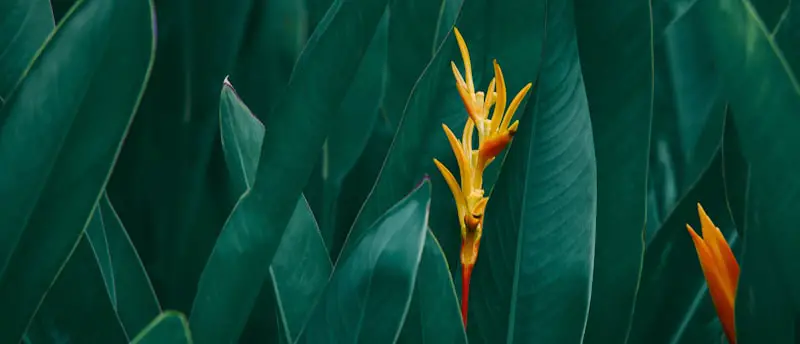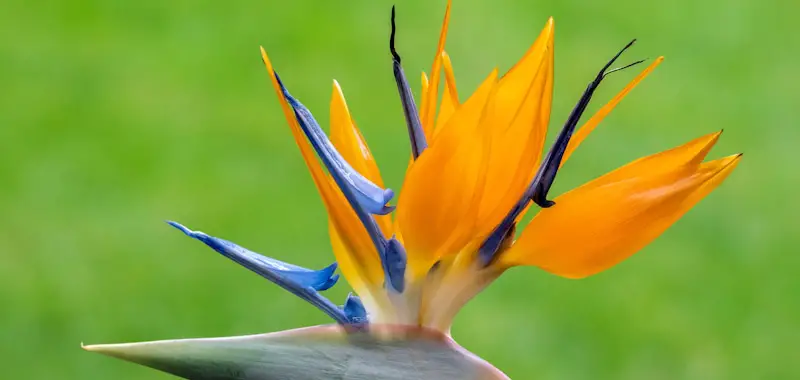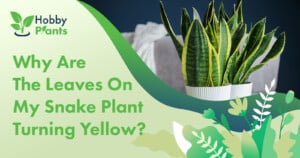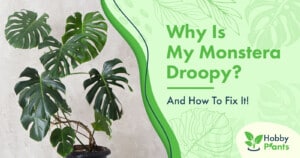The Bird of Paradise is instantly eye-catching in its maturity, making it a popular plant in any garden. Still, the plant’s leaves occasionally curl when there are issues. So, why are my Bird of Paradise leaves curling, and how can I fix them?
Poor watering, low humidity, and excess heat are the main reasons the leaves of a Bird of Paradise plant curl. You can quickly fix them by watering the plant adequately, using a humidifier, and keeping it away from any heat sources.
This article discusses the different causes for Bird of Paradise leaves curling in detail, along with the multiple fixes you can try to fix these issues.
Why Are My Bird Of Paradise Leaves Curling?
Underwatering
A Bird of Paradise requires less watering to maintain its health. The dirt should be damp and not dry. Sporadic watering robs the plant of humidity to support its biological processes. So, the plant grows a self-defense mechanism to prevent water loss by minimizing its surface area, resulting in curled leaves.
A poorly watered Bird of Paradise has yellow and brown leaves that appear dry at the borders. The leaves droop, and the plant’s growth is more drawn out than usual. The under-watered plant then dies without proper treatment.
Overwatering
A Bird of Paradise does not only have curled leaves with less watering but also with overwatering. The plant gets root decay disease with excess water, which promotes fungi and bacteria growth.
Overwatering the plant results in excess moisture, so the roots can’t absorb the nutrients and oxygen it needs appropriately. So, it becomes frailer, allowing the disease to progress due to the damp soil. Like an under-watered plant, an overwatered one also has yellow and brown leaves. The sickly plant looks limp and ultimately dies without treatment.
Cold Seasons And Dry Winds
Cooler temps and dry winds amplify the Bird of Paradise’s transpiration, resulting in curled leaves. Lower temperatures chill the stem and roots, which prevents them from absorbing water for the leaves and other sections. When the leaves don’t have adequate water, they curl to minimize their transpiration surface area.
Conversely, dry winds remove moisture from the leaves, soil, and surrounding sections. So, as the transpiration rate increases, the plant curls its leaves to minimize surface area for less water loss.
Less Humidity
The Bird of Paradise likes humidity between 60% to 80% to flourish, so its leaves curl in areas with less humidity. Low humidity means it has more moisture than its environment, so the evaporation rate grows to maintain the difference.
When water loss is significant, the plant’s leaves curl downwards to minimize their surface area. Low humidity also results in sizeable dry spots on the leaves and wilting. Indoor heating during winter is also a cause of poor moisture, so an indoor plant can also curl its leaves.
Higher Temperatures
The Bird of Paradise flourishes in temps between 65oF and 85oF. In higher temps, its leaves curl either up or down, especially near a window that faces south. Indoor heating also causes higher temps, resulting in curled leaves. Plants near heat sources tend to bend more since the high temp increases water loss. So, the plant’s leaves curl to cut surface area.
Pests
Sap-sucking pests like spider mites, mealybug, and thrips invade these plants, which results in leaves curling. These species suck the sap from the Bird of Paradise, reducing the plant’s moisture level. So, its leaves curl and also grow holes with brown or yellow spotting.
Direct Sunlight
A Bird of Paradise needs indirect sunlight and only some hours of direct exposure. If it’s in direct sunlight for too long, its leaves curl inwards, which makes it lose water sooner. So, it closes the leaves to lessen their surface area. Direct daylight also results in yellow, red, and pale leaves. The borders and tips grow brown, and the plant wilts and dies with time.
Shock
Potting, transplantation, or relocation of the plant can shock it, resulting in curled leaves. Its leaves curl in response to abrupt changes in its soil, daylight exposure, and location before it can adapt to its new surroundings.
How Do I Fix My Bird Of Paradise Leaves Curling?
Immediate And Frequent Watering
Firstly, verify if the first two or three inches of the earth are dry or 50% dry before managing a poorly watered plant. Stick your finger or a twig into the soil to check.
Spray the plant instantly with water until it drains through the holes. Conversely, keep the pot in a washbowl for around 40 minutes to moisten the soil. Once done, drain any still water in the dish. Then, water the plant frequently at different times to make a proper schedule to keep the dirt wet.
Repotting
Sterilize the leaves with minor root rot damage using watered-down hydrogen peroxide. Report the plant by following the steps below.
- Softly remove the plant from its pot by gripping the stem or leaves.
- Shake the dirt around the roots to take it out.
- Look for any black or brown spoiled roots and remove them using garden scissors or cutters.
- Wash the leftover roots using a hose.
- Pack a new, clean pot with fresh dirt. Make sure it has drainage holes.
- Put the plant inside the pot, beginning from the roots.
- Water the plant sparsely when the top inches of soil are dry till the roots after some weeks.
Moving The Plant
Keep the plant away from the direct wind to uncoil its leaves. Move it to a location indoors where there are no winds. In the winter, move the plant to hotter areas to avoid freezing. The kitchen or bathroom are ideal options since they have frequent heating.
Humidifier Or Misting
Make a microclimate environment indoors to stop the leaves from curling due to poor humidity. Keep a humidifier near the Bird of Paradise in less humid areas, or keep a pebble tray half-immersed with water beneath the plant.
Misting the plant twice a week can immediately fix its low humidity. If the plant is near heating vents, relocate them to other spaces with more humidity. Water it more frequently and keep it away from direct heat sources.
You can quickly fix high temp issues in the summer by watering the plant frequently. Recurrent irrigation of the plants allows them to retain moisture regardless of the increased transpiration rate. If your Bird of Paradise is close to a direct heat source, relocate it to another area with less heat.
Spraying Water Or Oil To Remove Pests
Cobwebs or holes in curled leaves point to a pest infestation of the Bird of Paradise. For a mild infestation, get rid of the pests using a hose. Conversely, remove them with rubbing alcohol and cotton pads. For a heavy infestation, use neem oil to spray the plant. Since there can be a reinfestation, spray neem oil on the plant monthly to prevent them from returning.
Shade And Relocation
Find some shade from direct sunlight to uncurl the plant’s leaves. That can spread the intense daylight, reducing its harmful effects on the plant. If your plant is near a window with natural sunlight, keep it in a space with indirect exposure. Adequate watering also helps prevent water loss in direct daylight.
Final Words
Taking care of a Bird of Paradise isn’t the easiest thing to do. You always have to keep an eye out for curled leaves and other signs that indicate that it isn’t growing correctly. But once you figure it out, you’ll have these gorgeous plants blooming and thriving in no time. Happy gardening!
Victoria is the owner and main author of hobby plants. She loves spending her free time in her garden planting and taking care of her plants. Victoria hopes you enjoy the content here!


![How To Propagate Bird Of Paradise? [Find Out Here] How To Propagate Bird Of Paradise? [Find Out Here]](https://www.hobbyplants.com/wp-content/uploads/2022/08/how-to-propagate-bird-of-paradise-300x158.jpg)
![Why Are My Orchid Leaves Turning Yellow? [Find Out Here] Why Are My Orchid Leaves Turning Yellow? [Find Out Here]](https://www.hobbyplants.com/wp-content/uploads/2022/07/orchid-leaves-turning-yellow-300x158.jpg)
![Why Is My Bamboo Plant Turning Yellow? [Find Out Here] Why Is My Bamboo Plant Turning Yellow? [Find Out Here]](https://www.hobbyplants.com/wp-content/uploads/2022/07/why-is-my-bamboo-turning-yellow-300x158.jpg)
![Why Is My Aloe Plant Turning Brown? [FIND OUT HERE] Why Is My Aloe Plant Turning Brown? [FIND OUT HERE]](https://www.hobbyplants.com/wp-content/uploads/2022/07/why-is-my-aloe-plant-turning-brown-300x158.jpg)
![How Often Do You Water A Snake Plant? [FIND OUT HERE] How Often Do You Water A Snake Plant? [FIND OUT HERE]](https://www.hobbyplants.com/wp-content/uploads/2022/07/how-often-do-you-water-a-snake-plant-1-300x158.jpg)
![How Big Do Different Types Of Azaleas Get? [Find Out Here] How Big Do Different Types Of Azaleas Get? [Find Out Here]](https://www.hobbyplants.com/wp-content/uploads/2022/09/how-big-do-azaleas-get-300x158.jpg)
![Bird Of Paradise Plant Care: [Complete Beginner's Guide] Bird Of Paradise Plant Care: [Complete Beginner's Guide]](https://www.hobbyplants.com/wp-content/uploads/2022/08/bird-of-paradise-plant-300x158.jpg)
![Why Is My Fiddle Leaf Fig Dropping Leaves? [ANSWERED] Why Is My Fiddle Leaf Fig Dropping Leaves? [ANSWERED]](https://www.hobbyplants.com/wp-content/uploads/2022/06/why-is-my-fiddle-leaf-fig-dropping-leaves-300x158.jpg)
![Why Are My Peace Lily Leaves Turning Brown? [EXPLAINED] Why Are My Peace Lily Leaves Turning Brown? [EXPLAINED]](https://www.hobbyplants.com/wp-content/uploads/2022/07/peace-lily-leaves-turning-brown-1-300x158.jpg)


